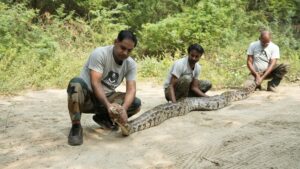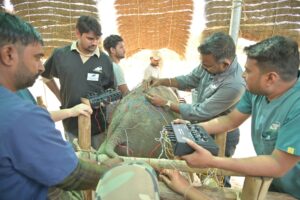Our veterinarians at the Elephant Conservation and Care Centre in Mathura were first introduced to the potential of acupuncture in wildlife care while searching for ways to help Bani, the orphaned calf who was left paralysed after a tragic accident. Determined to restore her ability to walk, the team began exploring alternative healing methods from ayurvedic oil massages to hydrotherapy. Their search eventually led them to Thailand and the ancient art of acupuncture.
There, they connected with Dr. Porrakote Rungsri, a Veterinary Acupuncture Specialist at Chiang Mai University and Dr. Huisheng Xie, Founder of the Chi University of Traditional Chinese Medicine in the USA. Under their guidance, our veterinarians learned the fundamentals of acupuncture and how this ancient practice could be adapted to treat various conditions in our resident elephants.

Before we explore how our veterinarians have applied acupuncture in the treatment of rescued elephants, it’s important to first understand what acupuncture actually is.
Understanding Acupuncture
The concept of Qi
Acupuncture is one of the main branches of Traditional Chinese Medicine (TCM) and Traditional Chinese Veterinary Medicine (TCVM), with roots tracing back over 2,000 years. At its core is the philosophy of Qi (气, pronounced “chi”), an invisible vital life force or energy believed to animate both the body and the universe.
According to this practice, health depends on the smooth and balanced flow of Qi through the body’s meridians, or energy channels. When Qi becomes deficient (too weak), excessive (too strong), or blocked, the body falls out of balance, giving rise to disease or physical and emotional distress.
Qi is not considered a tangible substance but rather an essential energy that permeates all of nature, extending beyond the human or animal body to include the interconnectedness of the mind, body, and environment. In this way, acupuncture is based on the idea that restoring the flow and balance of Qi can support healing and overall well-being.
While the concept of Qi may sound abstract to many, its application through acupuncture has shown practical benefits in veterinary medicine. By stimulating specific points along the body, acupuncture can help improve circulation, reduce pain, restore nerve function, and promote natural healing.
For our veterinary team, understanding Qi and the principles of acupuncture opened the door to exploring new ways of supporting Bani and other elephants under care that suffer from musculoskeletal injuries, nerve damage, or mobility issues, offering hope for recovery where conventional treatments had limitations.
Acupuncture Points and Meridians in Elephants
In Traditional Chinese Veterinary Medicine (TCVM), acupuncture points are specific locations where Qi (energy) is believed to accumulate. Stimulating these points helps restore the smooth flow of energy through pathways known as meridians. From a medical perspective, acupuncture points are rich in nerve endings, blood vessels, lymphatic channels, and mast cells. Many are located in areas prone to developing tension or “trigger points” where pain is present.
Acupuncture can be performed through various methods:
- Inserting fine needles
- Applying heat (moxibustion)
- Applying pressure (acupressure)
- Using laser light
- Passing mild electrical currents (electroacupuncture or EA)
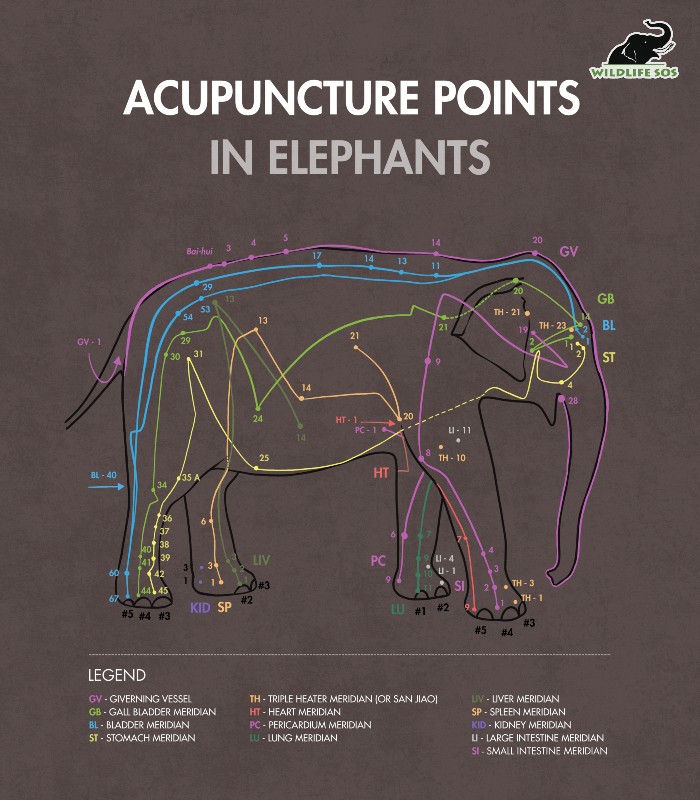
According to TCVM, Qi flows through 12 main meridians, each symbolically named after an organ system (such as B for Bladder, GB for Gall Bladder). These organs represent functional networks rather than exact anatomical structures. In addition, 8 extra meridians act as reservoirs that regulate excess Qi, maintain balance, and support overall health. This interconnected system means that stimulating one acupoint can influence distant areas of the body, making acupuncture a holistic approach to healing.
The Pathway of Pain
When the body is injured, damaged cells release chemicals such as prostaglandins, bradykinin, and substance P, which alert the nervous system. These chemicals activate nociceptors, special nerve sensors that convert the chemical signal into electrical signals. The pain signal is then carried by 3 main types of nerve fibres:
- A-beta fibres – transmit non-painful sensations like touch or pressure
- A-delta fibres – carry sharp, immediate pain signals
- C fibres – transmit slow, burning pain that may become chronic
Once the signal reaches the spinal cord, it can be modulated (amplified or reduced) by neurotransmitters such as
- Glutamate, which amplifies pain signals
- GABA (gamma-aminobutyric acid) and serotonin that reduce pain signals
- Endorphins, released as natural opioids that block pain
Finally, the brain interprets the signal, making pain both a physical and emotional experience. Many elephants rescued by Wildlife SOS have pain pathways overstimulated by years of abuse, poor nutrition and untreated injuries, making chronic pain a major challenge to treat.
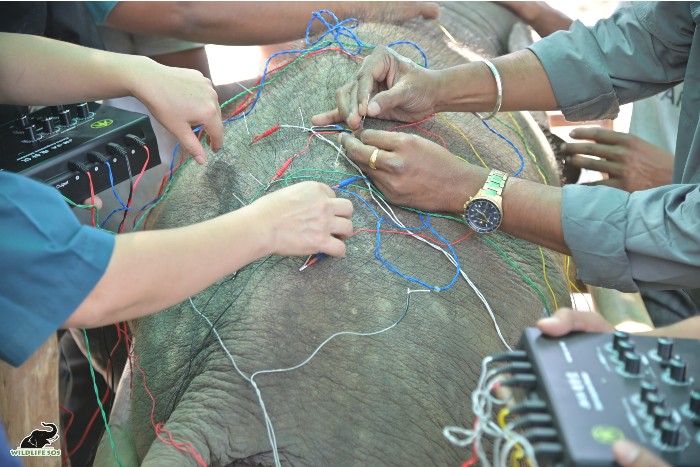
How Acupuncture Reduces Pain
Acupuncture alleviates pain through 3 interconnected mechanisms:
1. Local effects (at the inserted needle site):
Inserting a fine needle causes a small, controlled micro-injury, which increases blood flow, reduces inflammation, and triggers the release of substances like endorphins. The stretching of connective tissue around the needle activates nearby nerves, promoting healing and pain relief.
2. Spinal (segmental) effects:
At the spinal cord level, acupuncture can “close the gate” that allows pain signals to reach the brain. By stimulating A-beta fibres, acupuncture blocks painful signals carried by A-delta and C fibres. It also reduces pain-promoting chemicals like glutamate and enhances calming substances such as serotonin and GABA.
3. Brain (suprasegmental) effects:
Acupuncture activates regions of the brain like the hypothalamus and limbic system, which release endorphins, serotonin, dopamine, and other neurotransmitters that dampen pain. Advanced brain imaging studies have shown changes in pain-processing areas. With repeated treatment, acupuncture encourages neuroplasticity, helping the brain adapt and respond less intensely to chronic pain.
How Wildlife SOS has Utilised Acupuncture
Many elephants arriving at Wildlife SOS suffer from chronic health issues caused by years of neglect, inadequate diets, and limited physical activity. Our team of veterinarians integrates acupuncture with conventional veterinary care to support recovery and improve quality of life.
While acupuncture is not a cure-all, it has proven effective in alleviating pain, improving digestive issues such as colic and constipation, reducing inflammation, and enhancing overall wellness. Once our team gained expertise in acupuncture principles, we began applying it at our Elephant Hospital Campus, yielding remarkable improvements in several elephants.
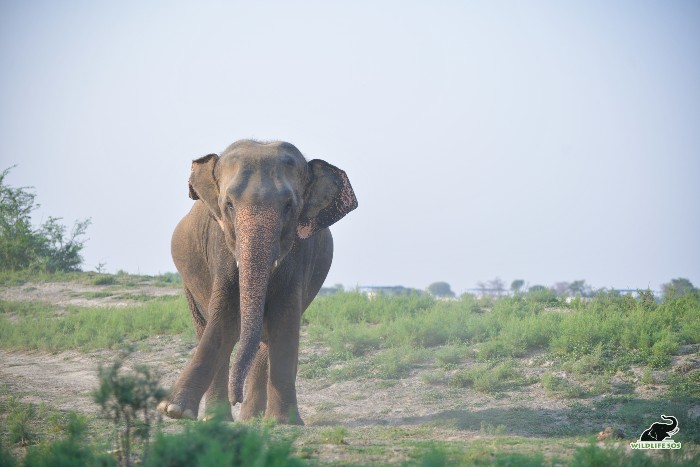
Colic And Digestive Issues – Raju and Taj
Elephants rescued from captivity often suffer from long-term digestive problems. Poor diets, unnatural feeding practices, and limited movement can result in conditions like colic and constipation that persist even after rehabilitation.
Raju struggled with recurrent colic, while Taj frequently experienced constipation. To support their recovery, our veterinarians combined dry needling and moxibustion (heat application) techniques:
- Fine acupuncture needles were inserted into acupoints related to digestion for about 20 minutes
- Moxibustion, using burning dried mugwort (Artemisia vulgaris) near the skin at specific points, stimulated circulation, warmed meridian pathways, and promoted bowel movement and gut health
This integrative approach, alongside diet and medication, helped improve their digestive function.
Chronic Pain, Arthritis And Ankylosis – Holly and Zara
Many elephants rescued from exploitation, especially those used in the begging trade, suffer from severe joint and foot disorders such as osteoarthritis, ankylosis (stiff joints), deformities, and infections. These conditions are often the result of forced standing on hard surfaces or walking long distances on unnatural terrain.
Holly experiences chronic arthritis and severe hindlimb pain, making walking difficult. Zara suffers from persistent pain due to ankylosis. To ease their discomfort, our team applied electroacupuncture and dry needling.
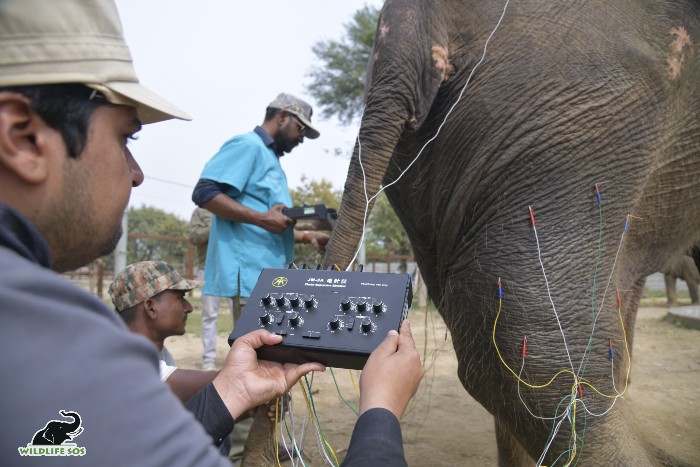
For Holly, whose stifle joint was injured in a fall, veterinarians also used a method called ‘circle the dragon’, where needles are placed in a circular pattern around the joint. This technique improves blood flow, reduces inflammation, and encourages healing.
Ventral Oedema Treatment for Vayu
Upon arrival, Vayu had ventral oedema in the perineal and abdominal regions. Along with conventional treatments and medications to reduce swelling, moxibustion acupuncture was applied to points along his belly and chest. The heat stimulated healing and improved circulation, helping reduce the oedema.
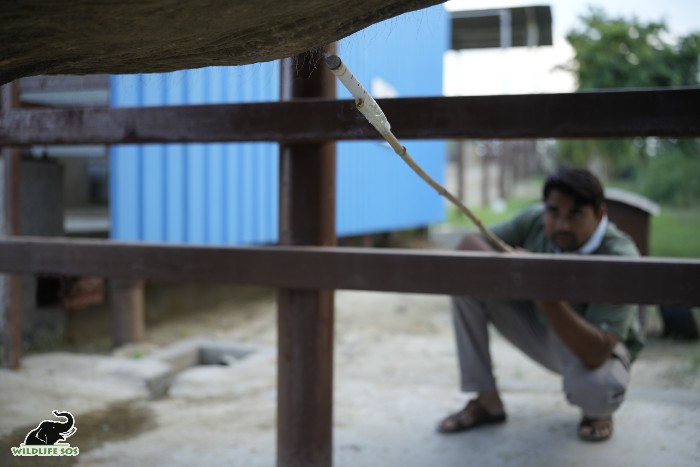
A Path Forward with Acupuncture
For elephants that have endured decades of hardship, healing is a gradual and complex journey. At Wildlife SOS, our veterinarians continually explore innovative ways to relieve pain, restore mobility, and enhance well-being.
Acupuncture has become a valuable therapy that works well alongside modern veterinary medicine. It addresses chronic pain, digestive issues, swelling, and mobility challenges in ways previously thought impossible.
Although acupuncture does not replace conventional methods of medical care, its integration has brought significant improvements. From Bani’s improving movement after paralysis to Holly, Zara, Raju, Taj, and Vayu’s gaining relief from debilitating conditions, these success stories affirm the power of combining holistic approaches appropriately with science-based treatments.If you would like to care for these rescued elephants, consider donating for their care.


